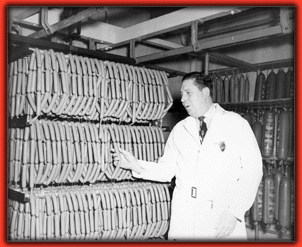
Alongside the orchards, butchers once flourished in the Santa Clara Valley. But while the fruit pickers' past is celebrated, only a select few honor the meat industry's gory days
By Kelly Luker
Forget about the prune orchards, the stands of cherry trees or the lettuce fields that once carpeted the Santa Clara Valley. Before this region became home to endless industrial parks and neatly packaged subdivisions, there were pastures as far as the eye could see. The morning air smelled of alfalfa hay and cow dung and--depending on where you lived--the blood of slaughtered cattle.When San Jose celebrates its agricultural past, the history of the beef industry and its once-numerous slaughterhouses remains locked in the closet like a family skeleton. It was of a different time, an era that recognized death as part and parcel to dinner--before cattle and other barnyard animals shouldered the burden of an evolving culture's political, emotional and spiritual agendas. Before these beasts had been bestowed souls, complex emotions and rights, they were food. And, more than food, they provided a way of life to families like the Pizzos, the Ferraras and the Righettis.
Motorists on the way to the San Jose Arena downtown still get a kick out of the smiling neon pig that blinks on and off above Stephens Meat Products located around the corner from the Bird Avenue exit off of 280. Unlike the business itself, the kitschy neon porker hasn't changed much since it first took up residence on that corner in the 1950s, although the business origins date back to the Depression era.
"This business was all old-time Italians--I was the Okie that came in," laughs Bob Morrison, the founder's son-in-law. A jovial man with a bushy walrus mustache, Morrison is seated today in a wood-paneled office adorned with cow and pig memorabilia. As he leans back and prepares to launch into another anecdote, his spotless butcher's coat gaps open. "I didn't want to come work here," he admits. "Back when we were young and dating the Pizzo kids, we used to tell each other, 'I ain't gonna end up working on the hot dog farm,' " he laughs. "But most of us did." That was back in 1960 and Morrison's "been on the farm" ever since.
Morrison's father-in-law got his start in the business delivering meat for the Sparr Brothers. Pretty soon Stephen Pizzo started sneaking in hams that he had smoked at home in order to make a little money on the side. When the Brothers Sparr found out, Pizzo was quickly on his own. "He started out of his basement with Matt Kovich [now deceased], who went on to form Denver Meats," Morrison recalls. "But, it was World War II that put 'em over the hump. Meat was hard to get then, but Steve [Pizzo] worked a deal with an uncle in the hills who raised some cattle. Steve would pay for it, Phil [Ferrara] would slaughter it and then deliver back to Steve and Matt."
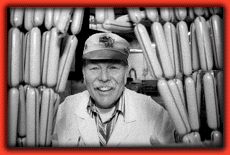
Photo by Christopher Gardner
Salad beats the meat: The salad days of the butcher business are long gone, but Stephen Pizzo holds on.
Like all good businessmen, Stephen Pizzo was a bit of a visionary. Back when virtually all meat was sold from behind counters, Pizzo saw the dawning of the packaged lunch meat age. "Steve was the first guy west of the Missouri to buy a vacuum-pack lunch meat wrapper," Morrison says. "They said he was crazy."
Beset By Weaker Links
Pizzo was presient in that regard, but he could not have foreseen other changes that were prepared to slowly erode his share of the marketplace. "Competition," Morrison sighs. "That's what's killing this industry. We can't compete with guys who are killing the beef."
Morrison is referring to what market analysts term vertical integration--when a business controls virtually every phase of its product. A company that owns the feedlots, the cattle, the processing plants and distribution routes will fare better in the marketplace than a company that can only contribute one of those services. It is huge conglomerates like Oscar Mayer, Armour and Swift that have steadily eased companies like Ferrara and Stephens toward the wall.
Even though his company now has to purchase meat from the big guys, it doesn't mean Morrison has to like them. In fact, he despises them. It is not only the headlock Oscar Mayer and Armour have on companies like Morrison's, but it is how, in the owner's opinion, they have hoodwinked the public into accepting inferior products.
Thwack! Thump! Thwack! Morrison reaches behind him and slams down several offending brands of links on the desk. "Look at this! When did you ever see meat this color?" he asks, pointing an outraged finger at a package of Ball Park Franks that echo a sickly taupe glow. I am willing to concede the point, but Morrison has barely warmed up. "Now, look at the ingredients--pappyreeka. Pappyreeka's no damn good as a spice with anything else, because it gets lost in the mix," he says. "It's got one use--as a coloring agent."
It takes a moment to understand the weakling spice in question here is paprika, but Morrison does not wait. He has singled out another criminal element in the mix. "Beef broth. That's what plumps 'em," the sausage man explains. "I shudder to think where that broth comes from." His mustache is fairly quivering with disgust at this point. "We don't need that, and our franks out-plump 'em all."
Before that point is driven home, Morrison is onto a package of his competitor's chorizo sausage. "Go ahead. Read the ingredients," he says, and leans back to listen to a list that includes salivary glands, lymph nodes and tongue trimmings. "It doesn't excite me seeing that on a sausage label," Morrison harrumphs with some understatement.
By the time he proudly displays the Stephens franks, breakfast sausages and chorizo, Morrison knows he has won a convert. His plump weenies burst with a healthy auburn glow. The chorizo is remarkably cheek and lymph node-free.
But forget trying to find these clearly superior links at the local grocery store. As the Oscar Mayers and the Armours flexed their muscles and elbowed most every other little wiener out of the deli case, Stephens saw the writing on the wall. Although shoppers can find Stephens' products at a few Lucky stores or Tropicana Foods, or grab a Stephens hot dog at Gourmet Pup on Bird and Minnesota avenues or Mark's Hot Dogs on Alum Rock Avenue, Morrison's company has carved out a different niche in such institutional turf as schools, hotels, restaurants and military installations.
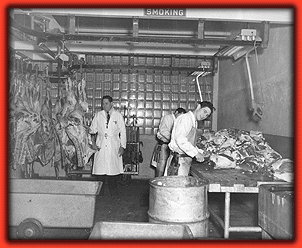
"If the demand were there, we could crank up the machines and flood this valley with weenies," asserts Morrison. "But your housewife, she don't know quality. She buys Oscar Mayer because they're a few cents cheaper and they spend millions on advertising."
As an example of how money talks, Morrison told of how Stephens had the hot dog concession at the nearby San Jose Arena. "But last year, Oscar Mayer came in offering a few hundred thousand dollars to put up a sign inside the arena," he recalls. Needless to say, the weenie supply no longer comes from Stephens. "But hey, am I complaining?" Morrison asks, spreading his hands wide, "I ain't complaining. That's business."
Down on the Hot Dog Farm
Speaking of business, is it true, as the old adage goes, that no one who appreciates sausage or laws should watch either being made? "They say that, I guess, because it's so grotesque watching sausage being manufactured," Morrison replies, then catches himself, but it is too late. Perhaps we can stroll through and watch, then?
The owner hesitates only a moment before tossing a butcher coat and cap to his interviewer. "USDA has a federal inspector on the premises every day," he explains. "We can't go in the plant without this." But, contrary to popular concepts, the sausage-maker likes the USDA nowadays. "They're great. They keep you on your toes." He tells of delivering meat years earlier to one of California's best-known grocery chains and discovering maggots in the hamburger grinder. "They only get periodic visits--we have to keep an office here on site for the federal inspector."
As if on cue, Emmet Cunningham appears by our side, toting his clipboard. Jutting out of his coat breast pocket is a black-rimmed tag with the word "Rejected" in large letters, no doubt a deterrent to workers. He walks with us to one of the many chilly rooms we will be touring. We first study the chopper, a huge machine that turns chunks of meat, fresh eggs, onions and spices into a consistency of--depending on the end product--chunky-thick or toothpaste-smooth. Staring at the giant pulverizing blades used in sausage making everywhere, one comes up with yet another plausible answer to Jimmy Hoffa's disappearance.
"In the meat business, sausage making is the top of the line," Morrison explains. "Anybody can kill, but making sausage come out the same every time? It's an art. Steve would hire a sausage maker from the old country on the spot. You know why? They learned the art by first feeding the animals and cleaning their stalls. Then they had to learn how to butcher. Then, then they were allowed to clean up after the sausage makers. Then, they got to apprentice with the sausage makers for a few years before they could go out on their own."
We are watching a worker toss pitchforks full of meat into the grinder. "The sausage foreman has one of the most important jobs, next to cleanup person," Morrison explains. "He's one of the only ones who knows the secret recipe--how much of this and how much of that." Morrison still remembers the sausage wars, the days when companies would stop at nothing to steal the recipe of a competitor. "Of course, the cleanup folks are the most important, because if the inspector finds even a piece of lint on a machine, we're shut down for the day." Cunningham nods his head in silent agreement.
We move to the next room, chilled to an even more glacial temperature than the previous one. This morning the assembly line is cranking out Italian sausage. At one end sits a large vat that is continuously being filled with sausage meat--today it is Italian sausage. At the other end awaits Emilio and miles of intestine. As the sausage squirts through a tube, Emilio expertly slips an intestine over the tube, smoothing it on like the world's longest condom as, yard by yard, it fills with aromatic meats.
Across the way the smokers for franks and other cooked sausages await us. Morrison is framed by thousands of links draped around hangers, waiting their turn in the heated rooms. "The smoking is an exact science, too," he says. "You don't just cram 'em in and turn on the heat. You start at one temperature then move to another. If you do 10 minutes over or under, you ruin the whole batch."
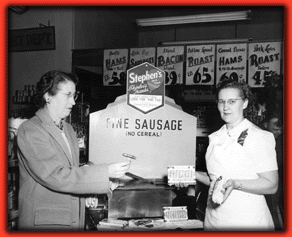
We're off to the meat storage room, whose temperature makes the earlier two departments seem like Florida in August by comparison. Teeth chattering, we ask if we can review the smoker rooms again. Morrison laughs, seemingly unaffected by the Arctic-type chill. He points to another grinder that is expressly made to pulverize frozen meat. The side is emblazoned with a ghastly rendering of bloody fingers dismembered from an equally bloody hand. "This little baby can chew up concrete blocks," Morrison says proudly.
As we head back to warmer climes, he explains the precision that goes into his art. What looks like several vats of plain ol' meat, he says, are actually different cuts carefully separated and laboratory analyzed for their fat content. Morrison grabs a pitchfork and stabs a slab, dangling a piece of pork up high to be examined. Shiny ribbons of sinew glisten under the fluorescent lights. "See? See how lean it is? Do you think Oscar Mayer would use this quality?" he asks rhetorically. We know the answer by now.
As we head out of production area, Morrison's brother-in-law passes by with a wave. Morrison's wife can be found working in the office, as well as a daughter-in-law. A couple of sons are also employed by Stephens. Although Morrison had his misgivings about throwing in with the hot dog farm, the last 40-some years have provided a pretty good living, yes?
"Oh yeah," Morrison grins. He's learned to love the business, all right, but he doesn't expect his grandchildren to have the same opportunity he did. "There'll be no Stephens for the next generation," he says with a wistful smile. "This size of meat company won't be around." He gestures to the workers, the huge vats and shiny choppers and graters that are ready to shut down for the day. "The smaller boutique businesses and conglomerates like Armour will be going strong, but our size is stuck in the middle--there's too much overhead to stay profitable."
Who Killed the Slaughterhouses?
For Phillip Ferrara, it might have been yesterday when he could look out his window on East Trimble to miles of pastures. He is 86 now, one of the few first-generation cattlemen still around. The others--Morrison at Stephens Meat Products or Sylvan Rosenzweig down at San Jose Tallow--are all second-generation meat folks. Now in their 50s and 60s, they have the stories all right, but most have been passed down like family heirlooms, pulled out at the dinner table and buffed up for another round.
If memory serves Ferrara right, there were about a half-dozen or so slaughterhouses still going strong in the 1960s. There was enough animal byproduct to keep three or four rendering plants busy, but now Sylvan and his son Mark barely have enough business to keep the fires burning at San Jose Tallow. Most of the other specialty houses have disappeared--the boners, who de-boned the carcass; the casers, whose sole purpose was to collect and redistribute animal intestines for sausage casings; the fabricators, who reduced carcasses to "primal," or large cuts--most have migrated toward the Midwest, enveloped into the giant beef conglomerates that now make their home there.
At Ferrara Meat Company, the elder Ferrara still runs the show. A holdout from a former era, Ferrara Meats squats in the shadow of high-tech neighbors that have risen together in the Golden Triangle, a patch of astronomically priced real estate bordered by highways 101, 880 and 237. The dingy packing shed juts out incongruously among the sleek chrome and glass buildings that are home to giants such as Honeywell, Hewlett-Packard and Unisys. The obsolete structure is considered an eyesore, a reminder to its wired and digital neighbors of a messier, bloodier era. But like the old man himself, Ferrara Meat Company refuses to give up and go away.
Bowing to community pressure and economic necessity, the company stopped butchering a couple of years ago and switched to brokering trucked-in frozen haunches of beef, cutting them into smaller pieces for delis, specialty markets and the occasional walk-in customer. The man shows no intention of retiring, and can be found almost every morning at his desk reviewing the paperwork and tapping the day's receipts into his adding machine.
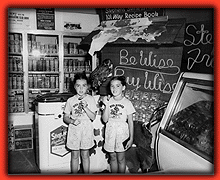
A Colorado-born cattleman who spent his childhood in Italy, Ferrara still shapes his phrases with a heavy Sicilian accent. The hearing is not so good, he says, but he remembers the early days well. He moves with agility as he gestures out the window toward the Corporate Express offices across the busy street. "I remember when that was all dairies, from Trimble to Capitol Expressway," the former rancher says.
Ferrara made his way out to the West Coast in the early '30s and jumped into cattle ranching after a stint in the steel mills. This time he points to the surrounding eastern foothills, explaining, "That's where the beef cattle were pastured." He is convinced those early 12-hour days of riding, roping and steer-wrassling are why he remains active and healthy today. "It was real work, back then."
The money was in processing, not growing beef, Ferrara discovered, and switched to the butchering business in 1946. Morrison, the son-in-law of Stephens Sausage founder Stephen Pizzo, loves to tell the one he heard about Ferrara, Pizzo and Matt Kovich, founder of the now-defunct Denver Meats, on that first day of business. "Steve and Matt went over to help Phil kill his first cow. The story goes that it took them eight hours and two jugs of wine to get that carcass loaded on the truck," he laughs.

From those inauspicious beginnings, Ferrara's slaughterhouse business grew, eventually processing about 300 head of cattle a day. For a country that had just suffered through years of rationing, postwar America was especially kind to the meat industry, and Ferrara's, Denver and Stephens prospered. The industry also provided a quality of living to its workers heretofore unknown. At one point it was one of the most heavily unionized fields and allowed people without education to enjoy a middle-class life. That has completely changed, and jobs in the meat industry have gone from the best paid to the worst paid since the 1970s.
Although the easy answer to beef's shrinking profile in this region is urbanization, it is not the full answer. The story of its disappearance from the Santa Clara area is the story of it disappearing from many of its traditional strongholds. It is not just skyrocketing land values, horrified NIMBY-asserting young urbans or the silicon chip's steady advance. Nor is it the burgeoning animal-rights consciousness or growing health concerns that have erased slaughterhouses and their related industries off of San Jose's map. As the nature of industry evolved from thousands of competing interests to a handful of conglomerates, beef was just one of many products that could not escape.
Ferrara's daughter Bernice Seimas "grew up in the slaughterhouse," as she likes to put it. A pleasant though perpetually busy woman, Seimas talks like someone who has been scorched by the media flames. She chooses her words carefully, ever mindful of the kicking around her birthright has gotten over the years. As Seimas sees it, the press began gunning for her industry as far back as the 1960s. And it seemed to have little to do with concern for either working conditions or the fate of the animals themselves.

The turning point came when Swift & Co., a large, Nebraska-based meat packing plant, looked to San Jose to build another facility. Unfortunately, their proposed site was a bit too close to the San Jose Mercury's newspaper plant. According to published accounts by the Merc's daily competitor, the Sun-Times, San Jose Mercury publisher Joe Ridder, never one to turn down new business in town, walked out of a community leaders' luncheon hosted for Swift officials when he heard the proposed location. Within weeks, Merc headlines screamed "Slaughterhouse Odor: 'The Stinkingest,' " and a front-page editorial instructed their readers "We Don't Need Slaughterhouses."
Although the Sun-Times exposed the motives as well as some of the questionable practices behind the Mercury's jihad, Ridder and his paper achieved their desired effect, forcing the Swift Company to locate in the more beef-friendly town of Stockton. "That pretty much destroyed the slaughterhouse business for the rest of us," Seimas recalls. "Nobody wanted to see where their meat came from, I guess."
The Bo-Peep Factor
The majority of the population still lived rurally at the turn of the century. It was an accepted part of life that the same chickens seen scratching in the yard that morning could have a date with the stew pot that evening. Beef or pork, when purchased at a local market, were cut from carcasses that hung within view.
Yet urbanization has erased any connection for most diners between live cows and Big Macs or between pigs and hot dogs. And the meat industry has done its share to collude with consumers, helping them avoid the stark reality. Seimas points to a poster from the 1940s that is framed and hung on Ferrara's office wall. A typical butcher shop handout, it portrays the silhouette of a steer, neatly sliced into popular cuts of meat. She then shows a recent American Beef Council flier that has the same cuts of meat. A cow, silhouetted or otherwise, is nowhere to be seen.
Zack Stentz, editor of an industry trade journal, Meat and Poultry Magazine, is familiar with this trend. He cites how the Beef Council commissioned--and quickly vetoed--an ad agency concept featuring gorgeous, lush commercials of cowboys rounding up cattle. "The idea was to engage the romanticism of the Old West. The Council nixed it because they didn't want to show live cows." Explains Stentz, "that's why you get ads that say, 'Beef--it's what's for dinner.' "
He also recounts an article he did about the lamb industry that upset lamb producers. It was not the content of the article that had the producers distraught, Stentz says. "They wanted me to come up with another term for lamb," he laughs. "They try to avoid what they call the Bo-Peep Factor." On the other hand, those who actually work in the slaughterhouses maintain an "admirable lack of euphemism," according to Stentz. "On a busy day, they'll say they 'got a lot of blood on the floor.' "
Bob Smith is pushing into his 70s now, but he cut his teeth in the meat packing business. His last slaughterhouse job ended when the Walti Schilling company in Santa Cruz closed down after 85 years in 1977. For Smith, it was automation that killed the industry. "Around 1960, they came out with the Johnson Hide Stripper," he recalls. "It could skin a beef in one minute with unskilled labor. Before that, we could only do 20 an hour. And we had to serve a three-year apprenticeship to learn the trade." With no pun intended, he admits that the slaughterhouses are a dying profession. "It's a joke with the older butchers today--novice butchers see a carcass and are amazed that meat doesn't come in little white packages."
He decided to go into business for himself and now offers his butchering services to farmers and ranchers under the catchy name "Have Gun, Will Travel." A typical week will find him traveling throughout the Central Coast from his home in Watsonville. Cattle, pigs, goats--he slaughters them all. Smith averages about four or five animals a week, "but it goes up during fair season," he adds.
Like Seimas, he has come to realize that most people have no idea where their steak or pork chops come from and prefer to keep it that way. Smith shakes his head. "In the old days, kids used to get all excited when they saw me coming. It was a big deal to watch the butcher at work," he remembers. "Now, people will holler stuff at me when I'm out in the field--call me a murderer." Asked what he thinks about those catcalls, he pauses. "I'm not a real religious man, but I do believe the Bible and it says animals with a forked hoof are for man to eat." But do they suffer? "Whenever I do an animal in, I do my darndest to do it with one bullet," he explains.
Smith's gun-for-hire business has spanned an interesting period of recent history. While the majority of consumers were getting ever more oblivious to what rested between their burger buns, a new culture was starting to pay attention, and didn't like what it was discovering. What Sinclair Lewis' The Jungle did to expose atrocious working conditions in the 1920s Chicago meat packing plants, books like John Robbins' Diet for a New America and Peter Singer's Animal Liberation began to do the same for the suffering and mistreatment of the creatures themselves. Ferrara's could not escape the growing outrage of animal activists and became the target in the late 1980s of protests and demonstrations as well as one arson attempt by a group calling itself the Animal Rights Militia.
On top of that, many began to question the morality of shoveling about a third of the world's grain supply into cattle feed while a billion people went to bed malnourished each night. Then, the American Medical Association weighed in with its verdict on diets heavy on red meat, and it was not a pleasant one. By 1993, yearly per capita beef consumption had plummeted from a high of 79 pounds in 1970 to about 61 pounds--almost a 25 percent drop in two decades.
Although concern for animal welfare, a starving planet and cholesterol-laden hearts had all taken their toll, the biggest contributing factor was probably cost. An average sirloin steak today will set consumers back about $4 to $4.50 a pound, a tenfold increase from 43 cents a pound back in the 1940s. By contrast, poultry has dropped to a quarter of what it cost about 30 years ago, and can often be purchased for around 40 cents to 50 cents a pound.
Stentz concurs. "Health concerns have contributed," he says, "but economics are thought to drive consumer behavior much more." Although a source of chronic irritation, the animal rights movement has had little significant effect on the meat industry, according to Stentz. "Except for veal, of course. But, that was a little niche market and it was easy to give up."
The Last Roundup
Bernice and I leave her father to his paperwork and make our way through the plant. Most of it is in disuse now, darkened rooms that only serve to collect dust. Seimas points to meat hooks hanging from conveyer belts that used to run along the ceiling. The sounds of our footsteps echo off the tin siding as we move from room to cavernous room. We sneak a look into the freezer locker, where perhaps three dozen sides of beef hang from the ceiling. Save one that still has legs attached, most no longer resemble cows.
They come this way from the giant packing plants in the Midwest, but even that is on its way out. Called "boxed beef," this method of shipment increased the shelf life of butchered beef from 10 days to almost six weeks. It also had a devastating effect on the butcher industry, and, although fought by the union, gained widespread use by the 1970s. As the meat industry began to consolidate, two resources were required: more land and cheaper labor--resources small towns in Iowa and Nebraska could easily supply.
The Midwest conglomerates are not satisfied with merely owning the land, the cattle and the processing to the point of boxed beef. There is yet another step they are hard at work on, according to Stentz. "It's obviously an advantage to have everything done at the plant. So now, they're trying to figure out how to process meat so it is 'case ready,' in its Styrofoam package and ready to be dropped in the meat case." The problem, explains Stentz, is trying to vacuum-pack the individual trays. "Sucking out the oxygen discolors the beef, and they haven't figured out a way to get consumers to eat purple meat."
The pressure of activists, the surrounding community and changing commercial requirements finally put an end to the truckloads of cattle shipped to Ferrara's for slaughter. By 1993, Ferrara switched to brokering the haunches and primal cuts, and discovered the profit to far outweigh the previous headaches of beef on the hoof.
Today, Bernice and her father are sitting on a gold mine, but it is not the packaging plant. As far back as the 1970s, Ferrara was offered almost $1 million an acre for the 23 acres that the plant sits on at the corner of Zanker and Trimble. It seems unlikely that Ferrara's grandchildren will shoulder the helm of an increasingly obsolete meat packing business given what sits right beneath it.
The pastures, the dairies, the slaughterhouses are all gone now. The boners and casers have moved on. Only a couple of fabricators--Mohawk Meat Company and Durham Packing Company--still call San Jose home. With the advent of boxed beef from the Midwest, there is barely enough animal byproducts to keep the last rendering plant in the region--San Jose Tallow Company--in operation. Tallow and pet food requires guts, fat and bone--the stuff that is now left behind on the slaughterhouse floors back in Iowa.
Bob Morrison is pretty philosophical about the twilight years of his hot dog farm and its related companies. "It happens," he says. "Hey, meat's been around thousands of years--how many things can you do with it?" The Midwest might answer--plenty. Like the tobacco industry, beef conglomerates have read the writing on the domestic walls and are now busy at work carving out brand-new territories in Asia, Russia and South America. This new world market spells little hope for the future of the Bob Morrisons or Phil Ferraras in this neck of the woods.
And, unlike the memories of fragrant cherry orchards and orange groves, few people sigh nostalgically for the days of "blood on the floor." In some poignant way, these dynasties have been robbed of both a future and a past. Except perhaps when the Morrisons or Ferraras get together and start bouncing those tall tales back and forth of how it used to be.
Over dinner. And a nice cut of roast beef, no doubt.
[ Features Index | Metro | Metroactive Central ]
